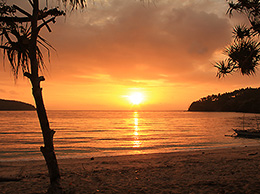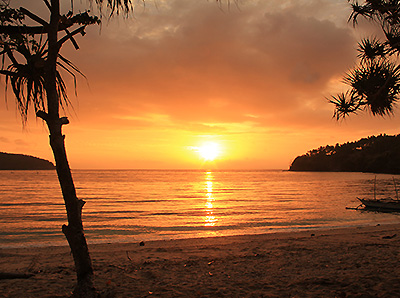Explorer Tourism Excels In Maestre De Campo (Sibale)
|
Photo courtesy: Girlie Cervantes
|
Beyond eons of time recorded, Maestre De Campo (also widely known as Sibale) was formed from the heart of the Earth in a prolonged volcanic eruption that punctured forever the surface of the Sibuyan Sea. The volcano island spewed millions of tons of lava, ash and rocks skyward, that fell back to the ocean floor to create one of the most intriguingly beautiful islands at the very centre of the archipelago that is known today as The Philippines.
As time passed, seeds blown on the wind added shrubs & trees that bats augmented with their pollination and fertilized seed dispersal. Coral larva, drifting on ocean currents, lodged in subterranean crevices and bloomed to become food and shelter for fishes. Mangrove seeds drifted on the tidal flows and found footholds in the corners of sheltered bays and inlets, their expansive roots sheltering fish fry from pelagic predation. The pulsating waves made sand that collected in coves, offering safe places for turtles to lay their eggs, while birds and bats enjoyed the young fruiting trees and made Sibale their home.
With approximately 1900 hectares of land, that rises to almost 340 metres above sea level, Sibale presents a series of steep-sided valleys and rugged promontories that stand defiantly against the wind and tides. Their weathered faces reveal the layer upon layer of rock and volcanic ash that fell here, with colors that range from pink and ochre through gray and almost black.
Spring water is abundant on Sibale for much of the year, and wets the forest and the coconut plantations. Small streams cascade down the steep valleys to nourish the sheltered lowlands areas. The streams carry almost no sediment, except where they traverse plantations, leaving the surrounding waters largely free from siltation. The result is crystal clear waters over sea-grasses and corals, throughout the year visibility of 15 meters is the accepted minimum.
For the explorer tourist Sibale offers the chance to delve into the past and appreciate a depth of biodiversity that is hardly touched by humans. Below the water and in the forested hills above, all manner of unique creatures thrive in small communities within the modest expanse of this previously volcanic island: birds, snakes, reptiles, spiders, fish, nudibranch, starfish, shrimp, beetles, plants and more.
Scuba Diving Sibale, Romblon
Scuba diving is a major attraction here, with 19 dive sites already identified and others still to be defined. The only challenge is that there is no dive shop on the island at the moment so you will have to bring all of the dive gear with you. However, the municipality is planning to invest in a dive compressor and tanks so that you will only need to bring your BC, mask and fins . . . more news about this shortly. With visibility reported up to 30 metres in most places the opportunity to explore wrecks and get up close and personal with pelagic fish, turtles and some exquisite corals is ensured. Macro photographers will be delighted by the acres of corals on walls and on the bottom that slopes away gently on the southern shores.
Hiking Trails Maestre De Campo / Sibale
Hiking trails to the two highest peaks have already been charted. Passing through a combination of forest and plantation you will find destinations like the pawikan / sea turtle sanctuary beach, the flag-pole rock and the protected forest trail. Most of the hiking trails are easy to moderate in difficulty, but if you want to get extreme then you can – there are rocky promontories that can be scaled with some risk but where the views are simply Jurassic.
Bird Watching Sibale, Romblon
Bird watching enthusiasts will find a feast for their cameras on Sibale. There are birds of every color, shape and size here: from black-naped orioles and emerald doves, to a variety of scub fowls and the strangely marked coleto. Many of the birds on Sibale are endemic to the Philippines and some are possibly unique sub-species found nowhere else on the planet. If you are a bird watcher you will find more than you bargained for here on the island of Sibale.
Paddling Maestre De Campo / Sibale
Paddling, in kayaks or native boats, around the island will provide a stunning backdrop from almost any direction. There are more than 30 beaches to paddle too but if you are into iron-man stuff then it may take around six hours to paddle around the entire island . . . but we recommend you instead stop at each of the nine barangays (villages) and share you thoughts with the local people, all of whom are only too pleased to greet explorers and to unveil the local delights. Paddling also will bring you close to the sea turtles (locally ‘pawikan’) that head for Sibale between the months of March and August – we were there in April and as may as nine turtles a day were seen in Poblacion Bay alone.
Snorkeling Sibale, Romblon
Snorkeling the crystal clear waters of Sibale provides so many encounters with the unusual. For example, pawikan / sea turtles and sea snakes. Gliding over the hectares of coral carpets here is tonic for the soul. Photographing the interplay of diverse species and procreation of others will be the delights that your underwater video will deliver globally via YouTube and other means . . . all real, all vibrant and some enigmatic. Snorkeling around Maestre De Campo / Sibale can only be described as enlightening and the only limit to the exploration is the extent of the island circumference.
If there are other things to do in Sibale then they could be SUP (Stand Up Paddleboarding), wall climbing and mountain biking. The only obstacle is that the machinery for these activities are not yet available on the island.
Alternatively, you could simply lay on the beach and watch the water rise and fall from sunrise to sundown, listen to the birds overhead by day and the flying fox fruit bats throughout the night, and wonder why you ever had to suffer the noise and pollution of the rest of the World.
Let the explorer in you run free and you will never regret a single day you spend on this magical island on the edge of the Sibuyan Sea.
I have been to Sibale, I love Sibale . . . and you will too.
For information about guided tours of Sibale contact the Sibale Tour Guide Association +63 926 551-1574
For more information about how to get to Sibale / Maestre De Campo, and other activities there, visit the All Sports Philippines dot com website Sibale pages, dedicated to the outstanding eco-tourism island of Sibale / Maestre De Campo.
Alternatively check out this new website promoting package tours for Sibale.



 Sunrise in Sibale from Poblacion Bay
Sunrise in Sibale from Poblacion Bay